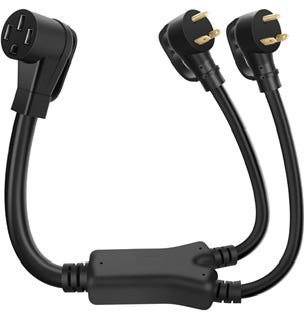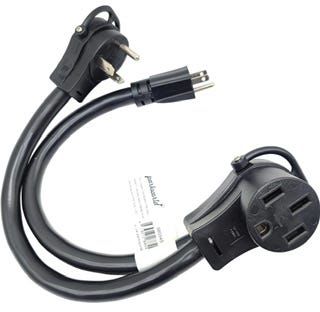Dear Mike
I have seen people using the 50 amp power cord on their coach to plug into a pair of 30-amp outlets. They plug their RV into a 50-amp Y-adapter which spits into two 30-amp male ends and then plug each end into a separate 30-amp outlet . They do this because there isn't a 50-amp outlet on the pedestal, but there are two separate 30-amp outlets. Is this safe to do for two weeks? -Tom
Hey Tom,
This is a possible solution as long as you understand the limitations.
Yes, this works!
Note that this type of adapter has a pair of 30-amp male plugs feeding a single 50-amp female outlet. However, there’s two different ways the 30-amp outlets can be wired on the pedestal(s) than can affect operation.
If the two 30-amp outlets are wired on opposite Legs of the split-phase 120/240-volt service, (One on L1 and the other on L2), then the neutral currents in your shore power cord will be subtractive so the amperage will never exceed 30-amps. This is exactly how a properly wired 50-amp outlet is supposed to work, except you’ll only have a combined current of 60-amps available instead of the 100-amps in the standard 120/240-volt NEMA 14-50 pedestal outlet.
But if both of the 30-amp pedestal outlets are wired on the same split-phase Leg (L1+L1 or L2+L2), then the neutral currents will be additive, so it’s possible that the neutral conductor in your shore power cord would reach 60 amps. While technically a code violation since that neutral is only rated for 50 amps, unless you’re pulling 30-amps continuously from both sides of your RV power it should be safe. So if you do use one of these adapters you’ll want to keep a watch on any signs of overheating on the 50-amp shore power plug.
No, this doesn’t work
However, these so-called 45 or 50-amp Y-adapters that are designed to plug into one 30-amp and one 20-amp pedestal outlet just won’t work. That’s because all all 20-amp outlets on a pedestal are required to have GFCI protection. And because the neutral currents between the two outlets are intermingled, the GFCI will instantly trip with any current over 5mA (that’s 0.005 amperes of load current). So don’t waste your money, because it can’t work with a GFCI outlet.
Let’s play safe out there - Mike







I think there is a typo in your article.
(L1+L1 or L1+L2) should read(L1+L1 or L2+L2).
If both 30 amp are on the outlet side of a 30 amp breaker wouldn’t the breaker keep tripping?